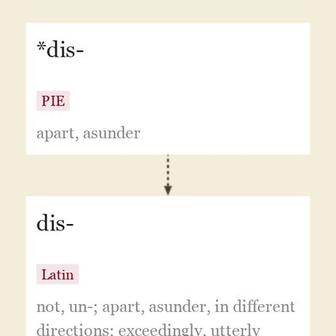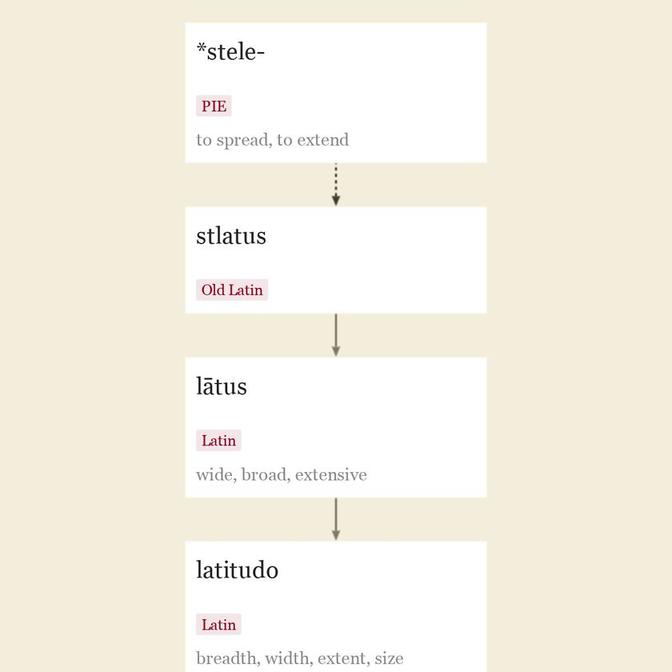dilatation (n.)
约于1400年, dilatacioun,“扩张的行为,扩张”,尤其是“身体孔隙的异常扩大”,源自古法语 dilatation,直接源自拉丁语 dilatationem(主格 dilatatio),“扩宽”,是拉丁语 dilatare 的过去分词词干,意为“使更宽,扩大”,由 dis- “分开”(见 dis-)和 lātus “宽广的,广泛的,广阔的”(见 latitude)组成。在中古英语中,“言辞的扩大”(14世纪后期)也有出现。在妇科学中, dilatation and curettage 于1896年开始使用。
dilatation 的相关词汇

拉丁语词缀,意为1. “缺乏,不”(如 dishonest); 2. “相反,做相反的事”(如 disallow); 3. “分开,离开”(如 discard),源自古法语 des- 或直接源自拉丁语 dis-,意为“分开,分离,朝不同方向,比喻为‘不,非’,也表示‘极其,完全’。在大多数有声辅音前,它被同化为 dif-,在 -f- 前被同化为 di-。
拉丁语前缀来自原始印欧语言的 *dis-,意为“分开,分离”(源自古英语 te-,古撒克逊语 ti-,古高地德语 ze-,德语 zer-)。原始印欧语言的根词是 *dwis- 的次生形式,因此与拉丁语 bis “两次”(最初为 *dvis)和 duo 有关,表示“两种方式,分开”(因此表示“分开,分离”)。
在古典拉丁语中, dis- 与 de- 相似,意思也差不多,但在后期拉丁语中, dis- 成为首选形式,并传入古法语中,成为古法语中形成复合词的形式,越来越具有否定意义(“不”)。在英语中,许多这些词最终被改回了 dis-,而在法语中,许多词被改回了 de-。通常存在混淆。
作为英语中的一个活前缀,它反转或否定了它所附着的词。有时,如意大利语中,它被缩减为 s-(如 spend, splay, sport, sdain 表示 disdain,以及姓氏 Spencer 和 Spence)。

14世纪晚期,“宽度”,来自古法语 latitude(13世纪)和直接源自拉丁语 latitudo “宽度,宽度,范围,大小”,来自 lātus(形容词)“宽,广,广泛”的古拉丁语 stlatus,源自 PIE *stleto-,是 *stele- “扩散,扩展”的后缀形式(源头还包括古教会斯拉夫语 steljo “展开”,亚美尼亚语 lain “宽”)。
地理和天文学意义也来自14世纪晚期,字面意思是已知世界地图的“宽度”。比喻意义上的“允许的变化程度,偏离标准的范围”早在15世纪就出现了。相关词汇: Latitudinal “与地理纬度有关的”(1777); latitudinous “解释宽泛的”(1829,美国英语)。
The ancients supposed the torrid and the frigid zones to be uninhabitable and even impenetrable by man, but while the earth, as known to them, was bounded westwardly by the Atlantic Ocean, it extended indefinitely towards the east. The dimensions of the habitable world then (and ancient geography embraced only the home of man ....,) were much greater, measured from west to east, than from south to north. Accordingly, early geographers called the greater dimension, or the east and west line, the length, longitudo, of the earth, the shorter dimension, or the north and south line, they denominated its breadth, latitudo. These Latin terms are retained in the modern geography of most European nations, but with a modified meaning. [George P. Marsh, "Lectures on the English Language," 1882]
古人认为热带和寒带是不适宜居住的,甚至是人类无法穿越的,但当他们所知道的地球向西被大西洋所限制时,它向东无限延伸。因此,早期地理学家称更大的尺寸或东西线为地球的 length,长度,较短的尺寸或南北线则称为 breadth,宽度。这些拉丁术语在大多数欧洲国家的现代地理学中仍然保留,但含义有所改变。[乔治·P·马什,“英语语言讲座”,1882年]
“扩张的行为”于1590年代形成,源于错误假设单词 dilate 中的 -ate 是拉丁语动词后缀(实际上它是词干的一部分); 该单词的正确形式是 dilatation(约1400年代形成)。